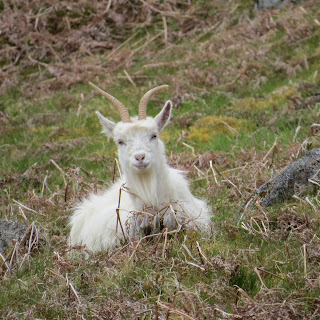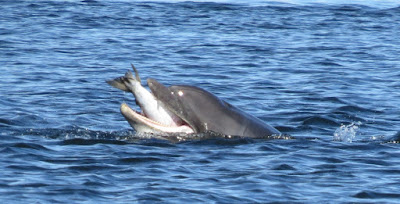June 2015 was certainly unseasonably cool and changeable weather-wise in this area, with the first week even seeing some overnight frosts and fresh snow on the higher peaks! However, there were enough decent days for it turn out to be another excellent month for wildlife sightings, and with around 20 hours of usable daylight and all of our summer visiting bird species on territory, bird day-lists are at their highest now, with full-day (12 hour) multi-habitat safaris regularly producing over 60 species, whilst mammal day-lists ranged between 5 and 9 species depending on the variety of habitats visited, with early starts proving most productive.
Just about every bird species seems to have youngsters now, though I fear the cold weather early in the month may well have adversely affected brood survival rates for some vulnerable species.
The combination of sun and rain helped to maintain the lush, green appearance of the spectacular highland scenery, with the wild flowers approaching their colourful best now, and a few more butterfly species were noted on the sunnier days.
I had some birding friends up from southern England mid-month, in search of all the 'Scottish specialities', so I have included a few highlights from our day-trip adventures, some of which were to locations beyond my Cairngorms National Park 'local patch'.....
 |
| Cairngorms moorland soon after dawn |
Wildlife highlights included:
Local speciality and upland bird species seen regularly throughout the month included: Dipper, Osprey, Goldeneye, Crested Tit, Black Grouse (early in the month only), Red Grouse, Slavonian Grebe, Red-Throated Diver, Black-Throated Diver, Short-Eared Owl, and Ring Ouzel.
A couple of trips high up into the Cairngorms produced the classic 'mountain-top' species, Ptarmigan, Dotterel and Snow Bunting.....
We also enjoyed some good dawn views of Barn Owl and Tawny Owl, and a few decent sightings of Red Kite, Hen Harrier and Golden Eagle, a couple of brief glimpses of Scottish Crossbill, and one memorable fly-over by a White-Tailed Eagle, though sadly Capercaillie (not unusually) did not feature at all this month....
Mammals seen regularly locally during the month included:
Red Squirrel,
Rabbit,
Brown Hare,
Mountain Hare,
Roe Deer,
Red Deer,
Reindeer,
Mountain Goat, Bank Vole, the local upland speciality
Black Water Vole, a couple of sightings of
Stoat, whilst a dusk 'stake-out' gave us a
Pine Marten, and a couple of coastal excursions provided
Dolphins,
Seals and an
Otter...
 |
| Osprey at nest |
Osprey is probably the 'star bird' of the mid-summer months up here - with my safari parties being fortunate enough to see them plunge-dive spectacularly to catch a fish, or delivering a fish to the nest on several occasions, and regular great views of the adult birds watching over their rapidly growing young in the nest...
 |
| Lekking Black Grouse |
Our local
Black Grouse continued to lek into June, with a pre-4am arrival giving us the opportunity to see the amazing 'Blackcock tango' for the last time this year.. often backed up by a 'supporting cast' of
Short-Eared Owl and
Barn Owl....
 |
| Red Grouse family (pic from June 2014) |
Red Grouse were not too difficult to find on suitable areas of heather moorland, and if you could spot the heads of the adults above the heather, you then usually got to see their large families of fast-growing youngsters too...
 |
| Ring Ouzel by Norman Green |
Ring Ouzels showed well in upland habitats near their nesting and feeding areas early in the month but became noticeably more elusive as the month progressed as they and their recently-fledged young began to roam further afield....
 |
| Crested Tit by Malcolm Fincham |
Crested Tits actually became a little easier to see this month, as the family groups foraged together through our local Caledonian Pine Forests , though it should be noted that they really are very 'flitty', and you certainly need to know their distinctive song and calls in order to be able to find them....
 |
| Scottish Crossbill (pic from June 2014) |
Crossbills as usual, were generally a bit elusive, though one day of serious 'forest bashing' mid-month eventually provided us with some half decent views...
 |
| Black-Throated Diver |
Both
Red-Throated Divers and
Black-Throated Divers in their dapper summer plumage, were seen regularly on suitable secluded local lochs, the latter with young, though we generally had our best views on calmer days, with little or no ripple on the water, and early and late in the day, when human disturbance was it it's lowest....
 |
| Slavonian Grebes |
Slavonian Grebes, also
in their beautiful summer plumage, were seen and enjoyed regularly by my safari parties on their favoured quiet lochans, though rather worryingly we could not yet confirm any much-needed breeding success for this increasingly scarce species....
Golden Eagle is not usually an easy bird to see in the summer months, as they have so many hours of daylight in which to hunt. It is just a case of putting yourself in a likely upland glen , and hoping you get lucky... fortunately we did on several occasions, though most of the sightings were at quite long range...
It was a similar story with
White -Tailed Eagle, though we got a real bonus on the 18th, when one of these huge raptors flew over our heads at unusually close range - a very memorable experience!
 |
| Ptarmigan by Malcolm Fincham |
June is probably the best month to have a chance of seeing all 3 of our mountain top bird species, and although suitable days weather-wise were few and far between, a walk up and around Cairngorm summit on the 16th gave us decent views of
Ptarmigan,
Dotterel and
Snow Bunting, though the low cloud prevented us from getting many really good photos...
 |
| Pied Flycatcher |
Other good birds of note seen this month included Cuckoo, Golden Plover, Redstart, Spotted Flycatcher, Pied Flycatcher and Wood Warbler, all of which can be tricky to see in large parts of the UK....
 |
| Icterine warbler by Bob Smith |
We also had a rare visitor this month, that is usually found much further east in Europe, in the form of an Icterine Warbler. This is obviously not a common bird in this area, and attracted a minor 'twitch', including myself and a few friends, and although it was typically difficult to see in the well leafed treetops, by following it's distinctive song, we did manage a few decent views...
 |
| Puffin on Handa Island |
June is also probably the best month in which to visit a coastal seabird colony, so taking advantage of a favourable weather forecast, the 15th saw us take a day trip up to the north-west coast to the wonderfully remote and beautiful
Handa Island. Even the short ferry crossing from Tarbet gave us super close-up views of
Seals,
Black Guillemot and
Red-Throated Diver, and once on the island, after our welcome talk by the SWT wardens, we went on to see
Snipe,
Red Grouse,
Wheatears,
Skylarks, and
Arctic and
Great Skuas galore nesting on the moors. Once at the impressively high cliffs and coastal stacks, we were treated to the unique sights, sounds (and smells!) of good numbers of
Fulmars,
Kittiwakes,
Razorbills,
Guillemots, and yes, everybody's favourite -
Puffins!
Onto mammals now....
 |
| Red Squirrel |
Our local Red Squirrels, a species sadly absent from much of the UK now, are always popular with my safari clients, and visits to my favourite Caledonian forest sites gave us lots of good sightings, often with decent photographic opportunities....
 |
| Red Deer by Norman Green |
Deer are always popular too, and early starts and a variety of habitats visited, gave us the chance of up to 4 different species......
 |
| Feral Mountain Goat |
Being absent from much of the UK, and only really found in remote upland areas, feral 'Mountain' Goats are a good mammal 'tick' for my safari clients, and we managed to see them on many of my safaris....
 |
| Bottlenose Dolphin by Bob Smith |
Dolphins are always high on most people's mammal wish-list when visiting coastal areas, and we are lucky to have probably the best land-based site in the UK nearby at Chanonry Point on the Black Isle, north of Inverness. A visit at the right stage of the tide on the 20th gave us superb close-up views of these entertaining and charismatic animals hunting the Salmon returning upriver to spawn...
So, despite the changeable weather, it looks like June 2015 can go down as yet another great month for wildlife-watching in and around the Cairngorms National Park, with the wide range of habitats visited producing a splendid variety of birds and animals, and all in wonderfully scenic surroundings.....
 |
| Spectacular Highlands scenery |











